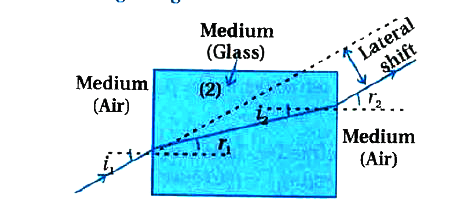Explain lateral shift for the refraction from rectangular glass slab.
 Solution in Gujrati
Solution in Gujrati
For a rectangular slab, refraction takes place at two interfaces (air-glass and glass-air).
It is easily seen from figure that r2=i1. i.e., the emergent ray is parallel to the incident ray there is no deviation but it does suffer lateral displacement/shift with respect to the incident ray.
Here, emergent ray is parallel to incident ray hence i1=r2. Thus, there is no deviation of incident ray but it experiences the lateral shift as compared to incident ray.
For more information :
If lateral shift is x, then
x=t×i2(1−n1n2)
where t = thickness of slab
n1 = refractive index of rarer medium (air)
n2 = refractive index of denser medium (glass)
i1 = incidence angle
Similar Questions
A light enters a glass slab of thickness t with angle of incidence i suffers lateral shifts(s).If angle of refraction of light is r , then lateral shift is equal to
View SolutionLateral shift produced by a glass slab is X. When the slab is immersed in a liquid for the same incident ray lateral shift produced will be
View SolutionA light enters a glass slab of thickness t with angle of incidence i suffers lateral shifts(s).If angle of refraction of light is r , then lateral shift is equal to
View SolutionA ray of light is incident at an angle, 45^@ rectangular glass slab of thickness 10 cm and refractive or index 3/2. Calculate the lateral shift produced :
View SolutionA ray of light is incident at an angle of 60° on one face of a rectangular glass slab of thickness 0.1 m and refractive index 1.5. Calculate the lateral shift produced.
View SolutionA ray of light is incident at an angle of 60∘ on one face of a rectangular glass slab of thickness 0.1m, and refractive index 1.5.Calculate the lateral shift produced.
View SolutionWhat is the lateral displacement in the refraction of light from a rectangular glass slab?
View Solution
